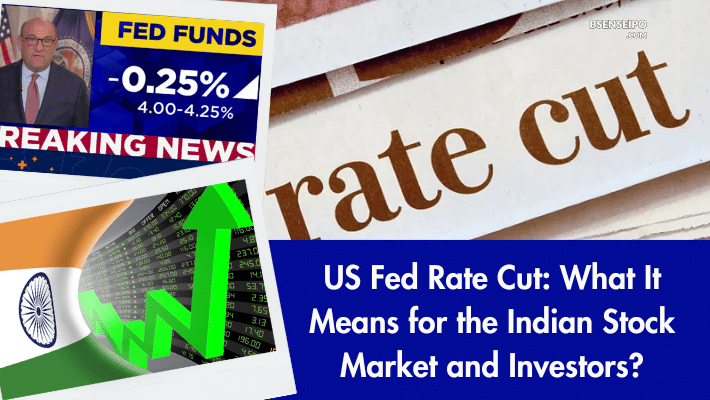What Does the US Fed Rate Cut Mean for the Indian Stock Market?
October 29, 2025 | Finance & Markets Insight | US Fed Rate Cut
US Fed Rate Cut 2025: In a much-anticipated move, the US Federal Reserve announced a 25 basis point (bps) interest rate cut on Wednesday, bringing the target range down to 3.75%–4.00%. The decision, following a two-day policy meeting, reflects growing concerns about slowing US growth and the need to stabilize financial conditions amid global uncertainty.
While this move is aimed primarily at the US economy, its ripple effects will be felt across global markets — especially in India, where foreign capital flows and currency dynamics are closely tied to US monetary policy.
The US Federal Reserve’s decision to cut interest rates has sent ripples across global financial markets — and India is no exception. While the move is primarily aimed at supporting the slowing US economy, it carries significant implications for the Indian stock market, foreign investment flows, currency movement, and sectoral performance.
Let’s break down how the Fed’s rate cut could shape India’s financial landscape in the coming months.
1. Boost to Foreign Institutional Investment (FII)
When the US Fed lowers interest rates, yields on US Treasury bonds fall, making emerging markets like India more attractive for global investors seeking higher returns.
As a result, foreign institutional investors (FIIs) often redirect capital toward developing economies — and India, being one of the fastest-growing major economies, stands to benefit significantly.
Impact: Increased FII inflows could lift indices like the Sensex and Nifty, especially in sectors such as banking, IT, and infrastructure.
Strengthening of the Indian Rupee
Lower US interest rates typically weaken the US dollar, which can, in turn, strengthen the Indian rupee.
A stronger rupee helps reduce India’s import bill (especially for crude oil) and keeps inflation in check.
However, if the rate cut leads to global risk aversion or fears of a US recession, investors might still flock to the dollar as a safe haven — limiting gains for the rupee.
Impact: Short-term volatility likely, but a stable or stronger rupee supports overall market sentiment.
RBI May Follow with Policy Easing
The Reserve Bank of India (RBI) often considers global monetary trends when framing its own policy stance.
A Fed rate cut gives the RBI more flexibility to ease domestic rates, especially if inflation remains within target.
Impact: Lower domestic interest rates can boost corporate borrowing, consumption, and investment — further supporting market growth.
Sectoral Winners and Losers
Different sectors of the Indian market will react differently to the Fed’s move:
Winners:
- Banking & Financials: Benefit from increased liquidity and lower borrowing costs.
- Real Estate: Gains from cheaper loans and renewed investor interest.
- Infrastructure & Capital Goods: Attracts long-term foreign capital inflows.
Potential Losers:
- IT & Export-Oriented Companies: A stronger rupee could hurt export revenues.
- Metal & Commodity Stocks: If the rate cut signals slowing global demand, commodity prices could face pressure.
Short-Term Volatility, Long-Term Opportunity
In the short term, markets may react sharply due to changing global sentiment and currency fluctuations.
But in the long term, the Fed’s rate cut could support global liquidity, attract foreign inflows, and boost valuations in India’s growth sectors.
As one market strategist put it:
“A Fed rate cut is like an adrenaline shot for emerging markets — it brings liquidity, lowers borrowing costs, and restores risk appetite.”
Investor Takeaway
For Indian investors, the message is clear:
- Expect near-term volatility, but use dips to accumulate quality stocks.
- Focus on domestic growth themes like banks, consumption, and infrastructure.
- Watch the rupee-dollar trend and RBI’s upcoming monetary policy for cues.
Conclusion
The US Fed rate cut is a global event with far-reaching consequences — and India, as a rising investment destination, stands to benefit.
While challenges like currency swings and inflation risks remain, the overall outlook for the Indian stock market remains positive, supported by robust economic growth and improving global liquidity.
In short, a Fed rate cut is good news for India — especially if it boosts foreign inflows and strengthens investor sentiment in the months ahead.




